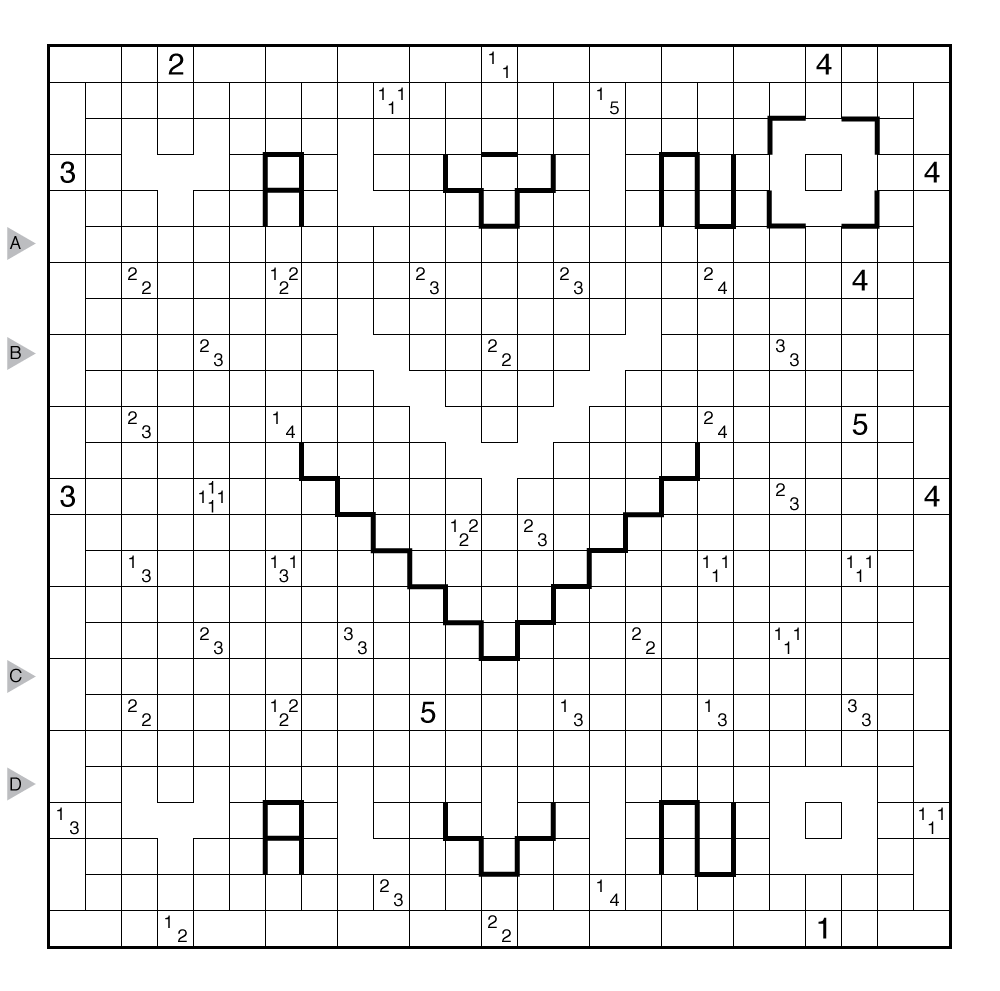Patron Puzzle: Tapa (Borders) by Prasanna Seshadri

(View image directly for larger form.)
or solve online (using our beta test of Penpa-Edit tools; use tab to shift between shading mode and the composite Yajilin mode where left click marks cells, right click marks dots in cells or X’s on edges, left click+drag draws lines.)
Theme: V is for Valvino (this puzzle was written for our patron Chris Green)
Author/Opus: This is the 74th puzzle from our contributing puzzlemaster Prasanna Seshadri.
Rules: Standard Tapa rules. Also, if two cells are separated by a thick border, this means that exactly one of those cells is shaded and the other is unshaded. (Cells missing a border that appear as larger shapes are entirely shaded or entirely unshaded. The count of shaded cells is always based on 1×1 squares, meaning if a “large” cell with missing borders occupies multiple 1×1 squares around a clue it would contribute 2 or more cells if shaded for that clue.)
Answer String: Enter the length in cells of each of the shaded segments from left to right for the marked rows, starting at the top. Separate each row’s entry from the next with a comma.
Time Standards (highlight to view): Grandmaster = 24:00, Master = 45:00, Expert = 1:30:00
Solution: PDF
Note: Follow this link for other Tapa variations and this link for classic Tapa. If you are new to this puzzle type, here are our easiest Tapa puzzles to get started on.

Little confused by the 23 clue at the bottom, does it not only have 6 spaces around it? Should there not be 7 so there can be 2 gaps between the coloured sections?
You need to still consider the “joint” cells as two individual cells. They are two different cells without a border which only describes the fact that both will behave the same, it doesn’t change the count.
*two or more
Knew I must be doing something wrong. Thanks.
I made the same mistake, and it didn’t help that I remembered having done another puzzle posted on this site ( http://www.gmpuzzles.com/blog/2013/08/the-puzzle-robot-2-tapa-irregular/ ) in which the numbers referred to the groups, not to the cells.
I recommend that this rule that multi-cell groups count more than once for clues be made explicit in the post.
Fabulaous puzzle, Prasanna!
Of all of the giant puzzles I’ve attempted so far, (many I’ve just skipped because they look like so much work), this was my favorite. I reaaly like the way the larger cells work within this one—as well as they large-scale “features” of the path itself.
It’s funny—about halfway through I changed my notation style from shading to drawing lines like one would for a loop puzzle. I just couldn’t see connectivity with my shaded cells otherwise no matter how much scribbling I did, (maybe I need to start using flood fill?). Fortunately, at the end I didn’t have any trouble counting cells even though I had line segments drawn in them. So I guess I am learning to be flexible to count either way.
-Carl
I actually considered doing the same thing, but I ended up sticking with the same flood-fill method that I usually use with Tapa. That said, I did struggle a bit with the continuity checking on this one. I got there in the end though. 🙂
– Neelix
One thing I do to help continuity checking on this sort of puzzles is to follow the white squares. If you can make a chain of diagonally connected white spaces that span from an edge to an edge*, you’ve disconnected the black squares.
*and obviously you need black squares on both sides of your white path — simply having a blob of white in one corner doesn’t disconnect the black…
Thank you for this puzzle, it was a great suprise!
Mmh, I’m really astonished, because I’m quasi sure I’ve found two other solutions.
The 1,3 clue at the bottom near the 5 and the two Vs could be “reversed”, which give two possibilities for the 2,2 clue.
I’ve a picture two show that, but I don’t know if it’s a good idea to post it there as there is a part of the solution.
And surely tomorrow morning I will see what is wrong with my other solutions, but right now I can’t manage to.
Lbh zvtug jnag gb purpx lbhe pbagvahvgl gurer. V pna bayl frr jnl gung pyhr pna or fngvfsvrq juvyr znvagnvavat pbagvahvgl orgjrra gur yrsg naq evtug fvqrf bs gur chmmyr.
– Neelix
Lrf, ohg gurer’f ebbz gb nffher pbaarpgvivgl orgjrra gur 1,3 naq gur oynpx obeqre yvggyr I.
Don’t forget that the black border has a mandatory colour change – you can’t connect the shaded ‘sea’ across the black border.
– Neelix
Oh …
Just saw that the middle cell of the little V was actually a double cell.
I really wonder why there are light gray borders in these multiple cells, that’s a pain during a computer solving to have to fill every little cell of the big V cell …
Thanks Neelix 🙂